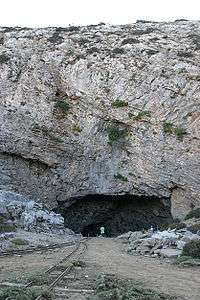Mount Ida
In Greek mythology, two sacred mountains are called Mount Ida, the "Mountain of the Goddess": Mount Ida in Crete; and Mount Ida in the ancient Troad region of western Anatolia (in modern-day Turkey) which was also known as the Phrygian Ida in classical antiquity and is the mountain that is mentioned in the Iliad of Homer and the Aeneid of Virgil. Both are associated with the mother goddess in the deepest layers of pre-Greek myth, in that Mount Ida in Anatolia was sacred to Cybele, who is sometimes called Mater Idaea ("Idaean Mother"),[1] while Rhea, often identified with Cybele, put the infant Zeus to nurse with Amaltheia at Mount Ida in Crete. Thereafter, his birthplace was sacred to Zeus, the king and father of Greek gods and goddesses.[2]
Etymology
The name Ida (Ἴδη) is of unknown origin. Instances of i-da in Linear A are often conjectured to refer to either this mountain or the homonymous one in Crete. Proclus considered it as the "mount of the Ideas", whence its etymology.[3]
Mount Ida, Crete

Crete's Mount Ida is the island's highest summit, sacred to the Goddess Rhea, and wherein lies the legendary cave in which baby Zeus was concealed from his father Cronus. It is one of a number of caves believed to have been the birthplace or hiding place of Zeus.[4] On the flank of this mountain is the Amari Valley, the site of expansion by the ancient settlement at Phaistos.[5] Its modern name is Psiloritis. The surrounding area and mountain used to be very wooded.
Mount Ida, Anatolia
From the Anatolian Mount Ida, Zeus was said to have abducted Ganymede to Olympus. The topmost peak is Gargarus, mentioned in the Iliad. Zeus was located in the Altar of Zeus (near Adatepe, Ayvacık) during the Trojan War. The modern Turkish name for Mount Ida, Turkey, is Kaz Dağı, pronounced [kaz daːɯ]. In the Aeneid, a shooting star falls onto the mountain in answer to the prayer of Anchises to Jupiter.
Notes
- ↑ Maarten Jozef Vermaseren and Eugene Lane. 1996 Cybele, Attis and Related Cults: Essays in Memory of M.J. Vermaseren, (Leiden: Brill), ISBN 90-04-10196-9, ISBN 978-90-04-10196-8
- ↑ Homer Odyssey xix. 172; Plato, Laws i. 1; Diodorus Siculus, v. 70; Strabo x. p. 730; Cicero, De natura deorum, iii. 21
- ↑ Anne D. R. Sheppard, Studies on the 5th and 6th essays of Proclus' Commentary on the Republic, Vandenhoeck & Ruprecht in Göttinger, 1980, p. 66.
- ↑ William Smith, ed. (c. 1873). A Dictionary of Greek and Roman biography and mythology. John Murray.
- ↑ C.Michael Hogan. 2007. Phaistos Fieldnotes, The Modern Antiquarian
External links
| Wikisource has the text of The New Student's Reference Work article about Mibora minima. |